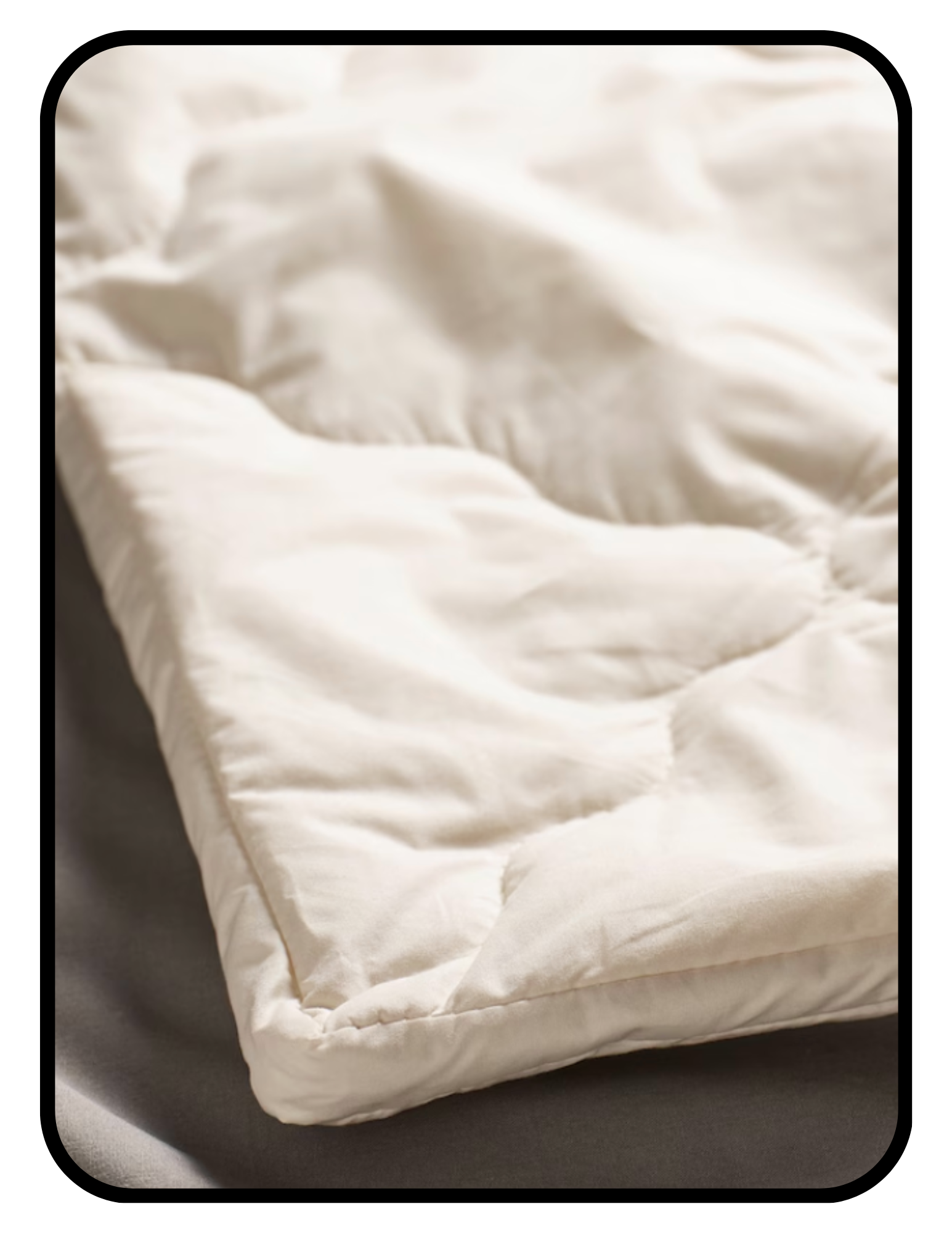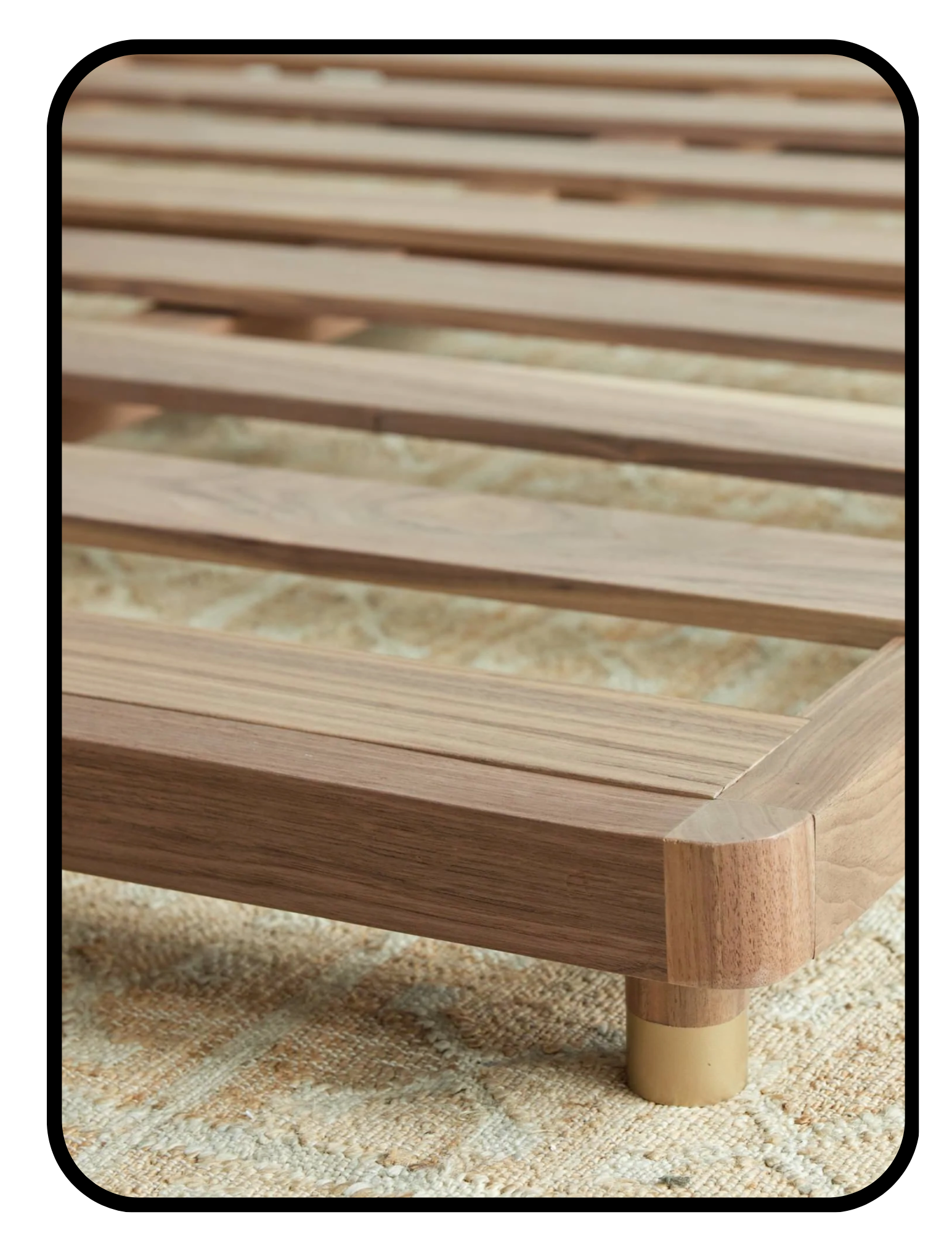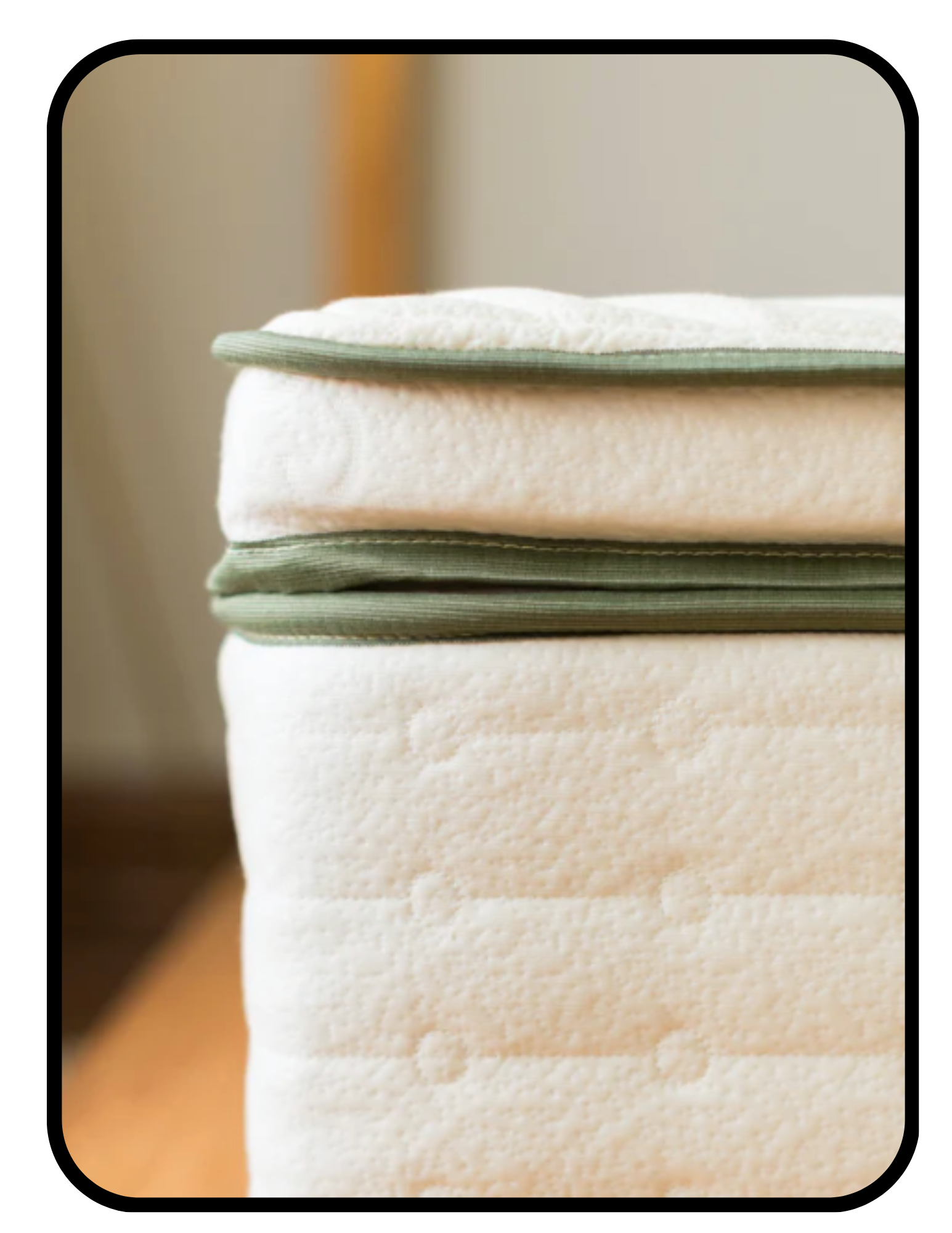Shop by Room ➜ Bedroom ➜ Comforters and Duvet Inserts
Non Toxic Comforters and Duvet Inserts
By Dr. Meg Christensen | Updated October 2025
Non-toxic and organic comforters and duvet inserts, analyzed for their health layer by layer.
Wool Duvet Inserts
Choose between a natural or GOTS certified organic wool duvet insert from Savvy Rest. Wool keeps you warm in the winter and cool in the summer because of its thermoregulating properties. Encased in an organic cotton outer. Can be spot, sun, or dry cleaned.
Sleep and Beyond
This organic Merino wool duvet insert by Sleep and Beyond has an organic cotton shell. Wool can be expensive, and these are both relatively affordable and totally GOTS certified to be organic. These come in a wide variety of sizes, from crib to Super King duvet inserts. Can be spot, sun, or dry cleaned.
Natural Alpaca Wool Duvet Insert. Like sheep’s wool, alpaca wool is breathable, thermoregulating, and moisture-wicking, but alpaca is known as a softer and more luxurious option similar to cashmere.This duvet insert from Avocado is made with natural alpaca fiber and an organic cotton percale outer, and comes in two weights— all season and lightweight.
IKEA
Natural Washable Wool Duvet Insert. IKEA offers the most affordable wool comforter. The outer is made of 100% undyed cotton, and the filling is 100% wool. While not organic, it’s great to see IKEA moving toward more natural comforter materials at an affordable price point, and the washability is a nice feature.
Wool Duvet Inserts
Down Comforters
WoolRoom
Organic washable wool duvet inserts. Breathable and thermoregulating, these comforters are what I use year-round. GOTS certified wool is encased in GOTS certified cotton, and you can choose either a lightweight, heavier weight, or combo that unsnaps into two smaller comforters, so you can change the warmth depending on the season.
Magic Linen
Magic Linen offers a lightweight OEKO TEX Certified Down Duvet Insert made with 90% down, 10% feather and a cotton shell. The whole thing is OEKO TEX certified to be free of harmful textile processing chemicals. The down is also certified to be humane and the entire thing is washable. Perfect if you’re buying one of their linen duvet covers, or on its own.
Pure Down
The best ultra light weight down comforter for hot sleepers and summer nights. Uniquely, Pure Down has colored options so you don’t have to add a duvet cover, making them extra cool. They use OEKO TEX certified Tencel from eucalyptus which is highly breathable, mixed with polyester for its shell, and 75% down with 15% feathers inside. The down is RDS certified humane.15% off with discount code INTMED15.
Silk and Silk Alternative Duvet Inserts
This washable silk duvet insert is made of ethical, recycled silk, which is a completely natural fiber, and is encased in a GOTS certified organic cotton duvet shell. Silk is known for being moisture-wicking, super breathable and temperature regulating, so you’re warm when it’s cool outside, and cool when it’s warm.
Made with Tencel and silk, this is a lightweight, temperature regulating comforter that’s breathable and keeps you just warm enough in the summer. OEKO TEX certified, it’s also washable, and has great ratings.
Down Alternative Duvet Inserts
This is the best down alternative duvet. It’s made with OEKO TEX certified polyester (microfiber). Too much polyester can trap heat, so it’s nice that at least the shell of this is made of cotton, minimizing any excess heat buildup. I also appreciate how it’s not made of recycled polyester, which can contain more unknown plastic processing chemicals than newly-made versions. Finally, polyester can be a good choice if you’re allergic to feathers, silk, or wool, or need a vegan duvet insert.
More Healthy Design for You
Pillow Inserts
More About Organic Bed Comforters
What are the best cooling comforters for hot sleepers?
My theory is that hot sleepers are just using the wrong bedding! In particular, too much polyester can trap heat, since it is plastic and not breathable. Any natural fiber including organic cotton comforter, TENCEL, TENCEL blends, silk, or down are the best types of bed comforters for hot sleepers, and you may even find that you don’t “sleep hot” after all. Watch a 1 minute video explanation here.
Are organic comforters worth it?
Yes, for two main reasons.
First, making fabric, including sheets, is a surprisingly chemically-intensive process. For natural sheets, if the fibers are grown conventionally, pesticides and fertilizers are used. Synthetic sheets (polyester, microfiber, etc) come from petroleum. Acids, scouring chemicals, and other processing agents used to wash fibers. Fiber-strengthening chemicals are aded to turn the fibers into sheets of fabric. Detergents, solvents, bleaches, acids, and enzymes are used to remove chemicals from previous steps, make the fabrics lighter, or prepare them to accept dyes in the next step. Pigments, binders, plasticizers, PVC, and other polymers (plastics) are used in this step, to make the dyes stick to the surface of the fabric. Finally, chemical treatments are added to make the fabric perform a certain way. Formaldehyde resins offer wrinkle-resistance, other resins work for anti-pilling, PFAS for stain-resistance, polyglycols for anti-pilling, acrylates or PVC with plasticizers for protective coatings, and flame retardants for fire resistance. Read more about this process and fabric in general in my Fabric Guide.
Second, organic fibers support better sleep. Polyester and microfiber are plastic, and trap heat and moisture, leading to frequent waking and unrestful sleep.
What is Tencel? What is Rayon? What is Viscose?
All three are semi-synthetic, plant-based polymer fabrics. Tencel is a brand of rayon. With viscose, the cellulose starting material comes from wood pulp. For rayon, it comes from cellulose that comes from other plants— eucalyptus, bamboo, soy, or cotton. Tencel is eucalyptus-specific. With all three, the cellulose is extracted and a solvent is added to make it liquid, then it’s re-formed into fibers. It requires less pesticides and water than conventional cotton production and is certainly better for people and the planet than a petroleum-based fabric, but still isn’t as healthy as a truly natural fabric from a material perspective. However, it is very breathable and has good moisture-wicking properties, so can support healthy sleep, which is healthy in itself. These products generally earn an OK! rating from me.
Is polyester safe?
Polyester is the best-known synthetic textile, and is actually the same thing as PET (polyethylene terephthalate), what plastic bottles are made of. This is why you see clothing, sheets, and other fabrics advertised as being made from recycled plastic water bottles. Polyester itself is relatively stable once it’s made, meaning it doesn’t make its way into your body easily. In that sense, it’s safe.
Polyester’s health issues come from the chemicals that tag along with it. Antimony is used in the chemical reaction to make polyester, and it remains on the polyester in the final product. Antimony is a metallic element that is associated with lung irritation, and is possibly carcinogenic. BPA, phthalates, and other additives are very commonly mixed with polyester to make the fabric softer, more durable, flexible, and colorfast. Phthalates are absorbed directly through the skin and is linked to developmental and reproductive harm, cancer, metabolic disorders, diabetes and more, with worse health effects in infants and toddlers. Recycled polyester is made from plastic of unknown origin and date, so can contain unknown harmful chemicals. Finally, the process of making polyester poses cancer risks to the factory workers, and virgin polyester requires fossil fuel extraction and petroleum refining, posing long-term health risks to the earth and everyone on it.
All that said (!), polyester tested to have no impurities left on it can be essentially harmless to the user. This is especially true if it has GRS, OEKO TEX, or MADE SAFE certification, which ensures it’s not mixed with BPA or PFAS. It’s still a better choice for fillings than polyurethane foam, and a much better choice of fabric than PVC. It is good for waterproof applications, as it’s naturally water-resistant and dries quickly, reducing the need for PFAS. It also doesn’t off-gas, so can be a good low VOC fabric. Finally, it’s inexpensive. I use it for lower-contact uses in my home, like in my shower curtain and blackout blinds.
Why don’t you recommend recycled polyester comforters?
Recycled polyester is typically sourced from plastic water bottles. These water bottles may have been made with plastic additives including BPA, heavy metals, and antimony— and may have been made decades ago or in countries with less strict regulations. While it is great to remove plastic water bottles from the ocean, I don’t recommend snuggling up with these products.
What does GOTS certified mean?
GOTS is short for the Global Organic Textile Standard.
It is the gold standard 3rd party certification for organic fabrics made from natural fibers like wool, cotton, linen, and others.
Fabric with the GOTS-certified organic label means that at least 95% of the starting fibers are certified organic, and ensures that the fabric remains healthy throughout the entire manufacturing process. This means the dyes and other chemicals used are safer for human and ecological health than standard fabric processing methods. No harmful finishes may be added to the final product.
What is OEKO TEX?
OEKO TEX certification applies to the finished product only, and is for both natural and synthetic textiles. Organic fibers, as well as man-made fabrics like polyester can both qualify, depending on what chemicals, and how much of them, are left in the final product. It does allow for some harmful chemicals, but in much lower quantities than are used in standard textile processing. You can see their limits, which are updated annually, here.
What is OEKO TEX Class I?
OEKO TEX has four product classes: I, II, III, and IV. Class I products have met the strictest requirements and limits, and are certified to be safe for babies and toddlers to touch. Babies and toddlers are more vulnerable to harmful exposures because their detoxification systems aren’t fully developed, they engage in hand-to-mouth behavior more often, and their cells are dividing rapidly as they grow, meaning they are more susceptible to mutagenic exposures.
Class II means direct skin contact is safe for adults, and applies to textiles like sheets and pillowcases. Class III and IV are still much safer for you than standard fabric processing— I really want to emphasize that! — and are reserved for items without direct skin contact, decorations, and home textiles you don’t touch very often (like curtains, for example).
Shop by Room ➜ Bedroom ➜ Comforters and Duvet Inserts
























